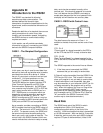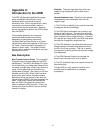
44
baud.) The typical data string 5.1270<cr>
has 7
characters, requiring 4 msec to be sent.
Stop Bits
Generally, selection of 2 stop bits will result in
fewer data transmission errors.
Parity
The Parity bit provides a check against faulty
data transfer. It is not commonly used in local
data transmission environments. If the parity
option is selected, the SR530 will transmit 8 data
bits and a parity bit, however, no parity check of
incoming data is done.
Voltage Levels
The RS232 uses bipolar voltage levels:
The control lines use positive logic. For
example, the DCE tells the DTE that it is clear to
send (CTS) by placing > +3 VDC on pin 5 of the
interface. Similarly, the DTE can tell the DCE
that it is not ready by placing -3 VDC on pin 20
(DTR) of the interface.
The data lines, pins 2 and 3, use negative logic.
A 'zero' bit is represented by a positive voltage
and a 'one' bit is represented by a negative
voltage. A start bit is a positive voltage and a
stop bit is a negative voltage. Data is
transmitted with the least significant bit first. The
letter 'A', which has the ASCII code 41H (0100
0001), would appear as follows:
If a parity option was selected, the parity bit would
be sent after the 8th data bit, but before the first stop
bit.
Final Tip
When you are trying to get the RS232 to work with
your computer, it is helpful to be able to 'eavesdrop'
on the RS232 data lines going between the SR530
and the computer. This can be done with an ASCII
RS232 terminal and the following connector:
To test the connector, place the hook clip on pin 2 of
the same connector (shorting pin 2 to pin 3.) Now,
when you type at the terminal keyboard, data
transmitted from pin 2 is received at pin 3 and
displayed on the terminal screen. To use as a
debugging tool, attach the hook clip to either pin 2 or
pin 3 of the RS232 cable on the SR530 to show
either data sent from the Computer or the SR530.
The baud rate, parity, and stop bits of the terminal
must match those of the SR530 and the computer.
If your terminal has a mode which will display control
characters (such as carriage returns and line feeds)
it is helpful to operate in that mode.
A variant of the 'eavesdropping' approach is
diagrammed below:
With this cable arrangement, the ASCII terminal can
listen to the data passing in both directions. The
only drawback is that the terminal will display
garbled data if both devices transmit data at the
same time.


















